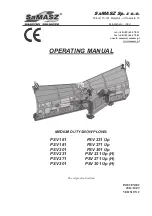
Electrical connection
22
SOLID-2SF-M
Leuze electronic
Review status, , Mittwoch, 8. April 2015
DEUTSCH
E
NGLISH
FRAN
ÇAIS
ITALIA
N
O
ESPAÑOL
N
EDERLANDS
Caution!
For optimum shielding, cables where the shield is routed on the knurled nut of the
connecting cable socket must be used (suitable cables are listed under accessories in
Chapter 9.3).
6.1.2
Testing
Caution!
In fault-free operation the cyclical internal testing delivers an alternating signal on the Dyn
SSD between low and high every 300 ms. Faults found are signaled by a static signal.
The downstream control unit must evaluate the safety-relevant aspects of this signal and
activate a machine stop if the signal does not change.
There is also the option of an external testing, with which the SSDs of the Receiver switch
off consecutively as a response to the creation of a test signal on the Transmitter. If external
testing is required, the Transmitter's test input must be wired accordingly (see below).
In most cases, however, internal cyclical testing is sufficient. For this purpose, the
Transmitter's test input must be permanently connected with +24V DC.
Internal cyclical testing
To activate external testing, connect Pin4 of the Transmitter permanently to +24V DC.
When using the internal cyclical testing, the corresponding SSDs and the shared Dyn SSD
must always be evaluated for safety relevance by the downstream control unit.
External test signal
To use the external testing option, connect the test output of the corresponding test
monitoring unit with Pin4 of the Transmitter. When using the external testing procedure in
combination with a test monitoring unit, only the SSDs must to be connected to the test
monitoring unit.
Note!
External testing takes precedence over internal testing. If the external test is used, a
corresponding frequency of the dangerous movement (typically at least 10 times as
frequent) is sufficient to guarantee test frequency.
Test input Pin4,
Transmitter:
+24V DC
Test = not activated
High impedance or 0V
Test = activated
















































